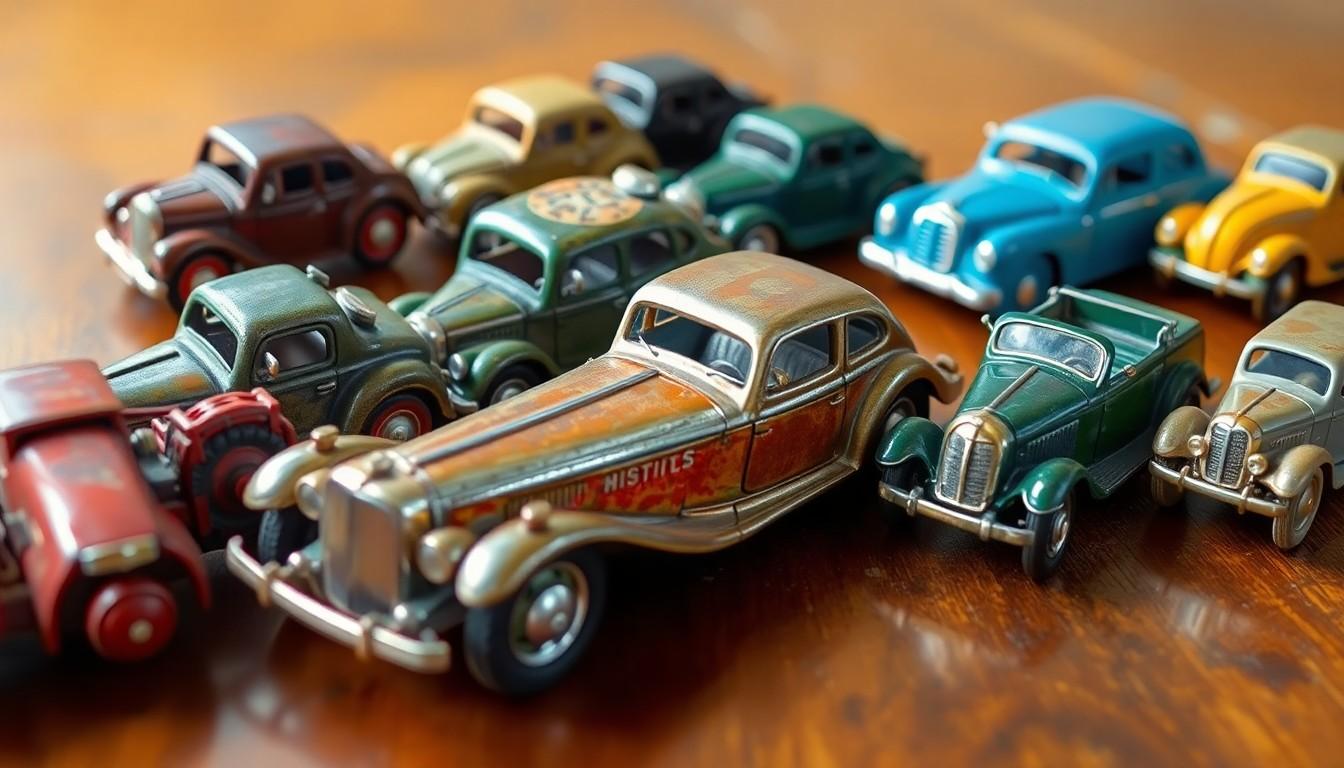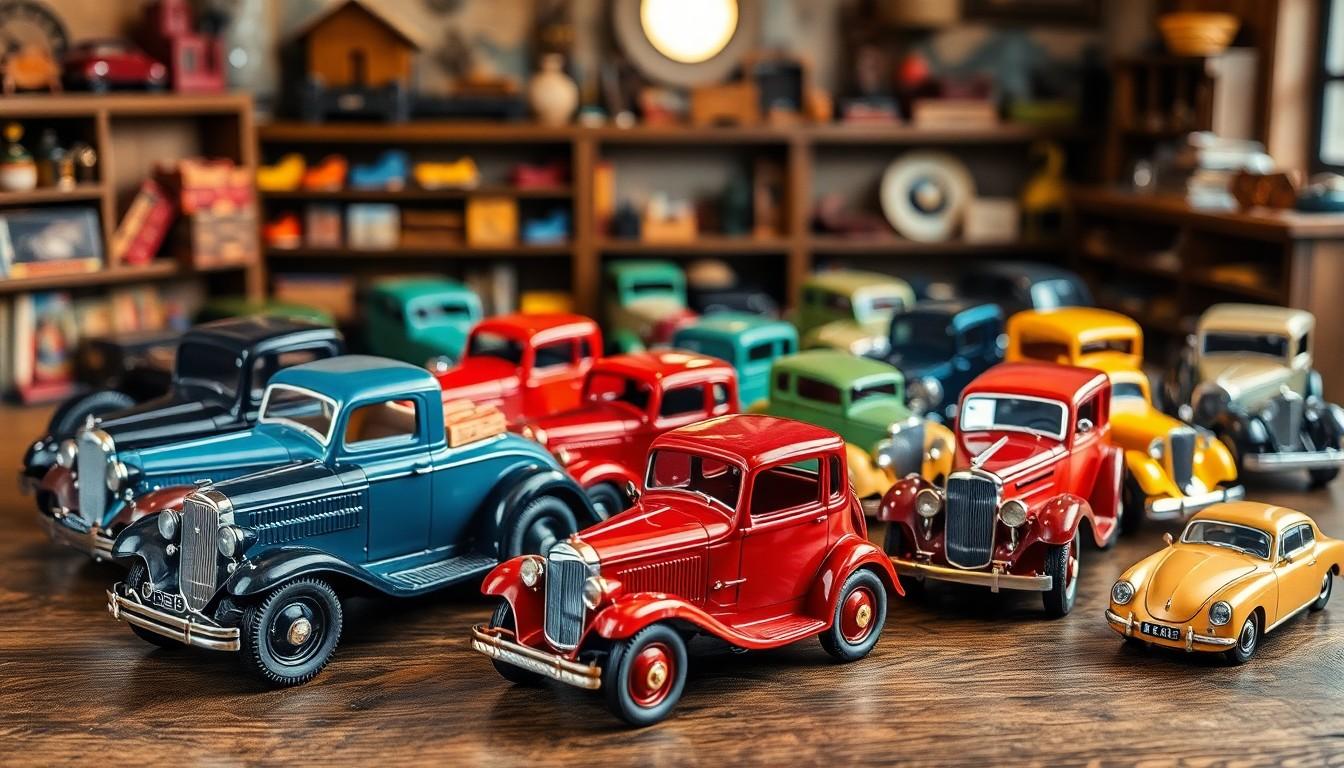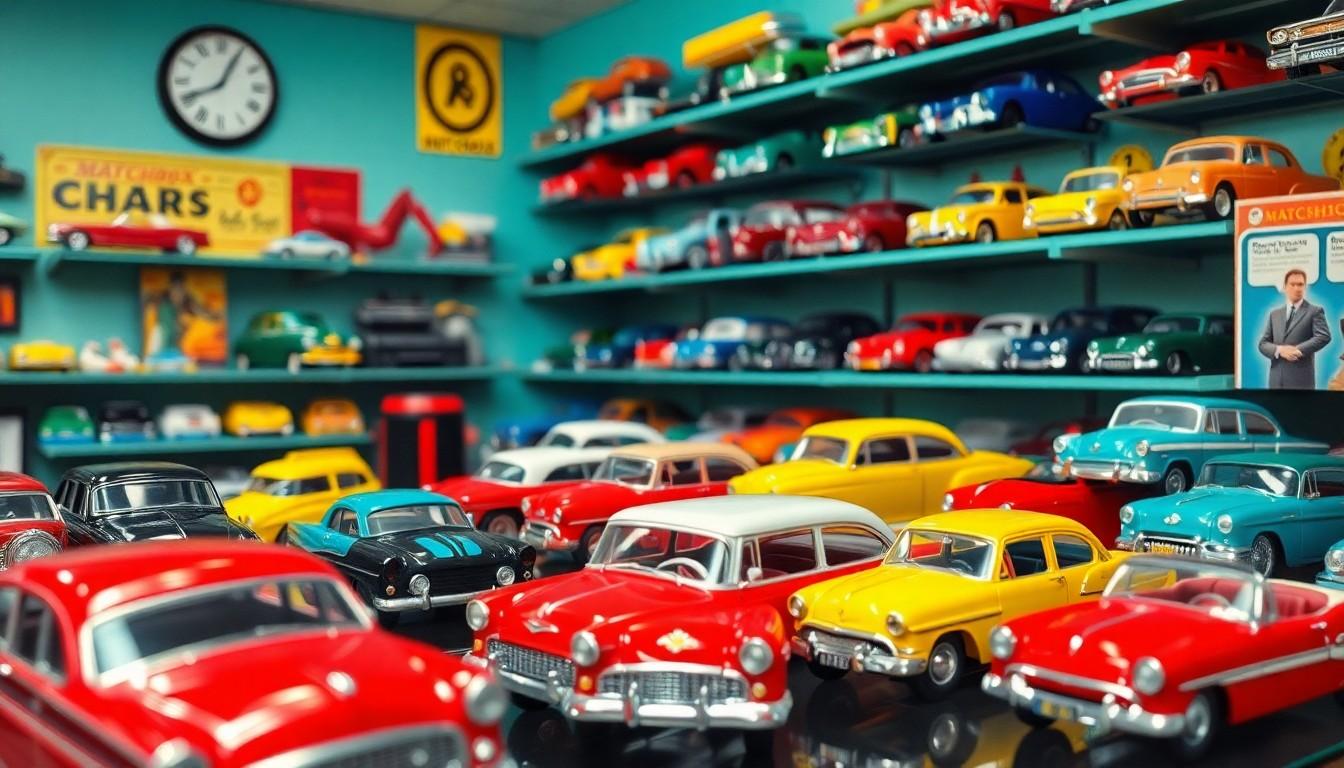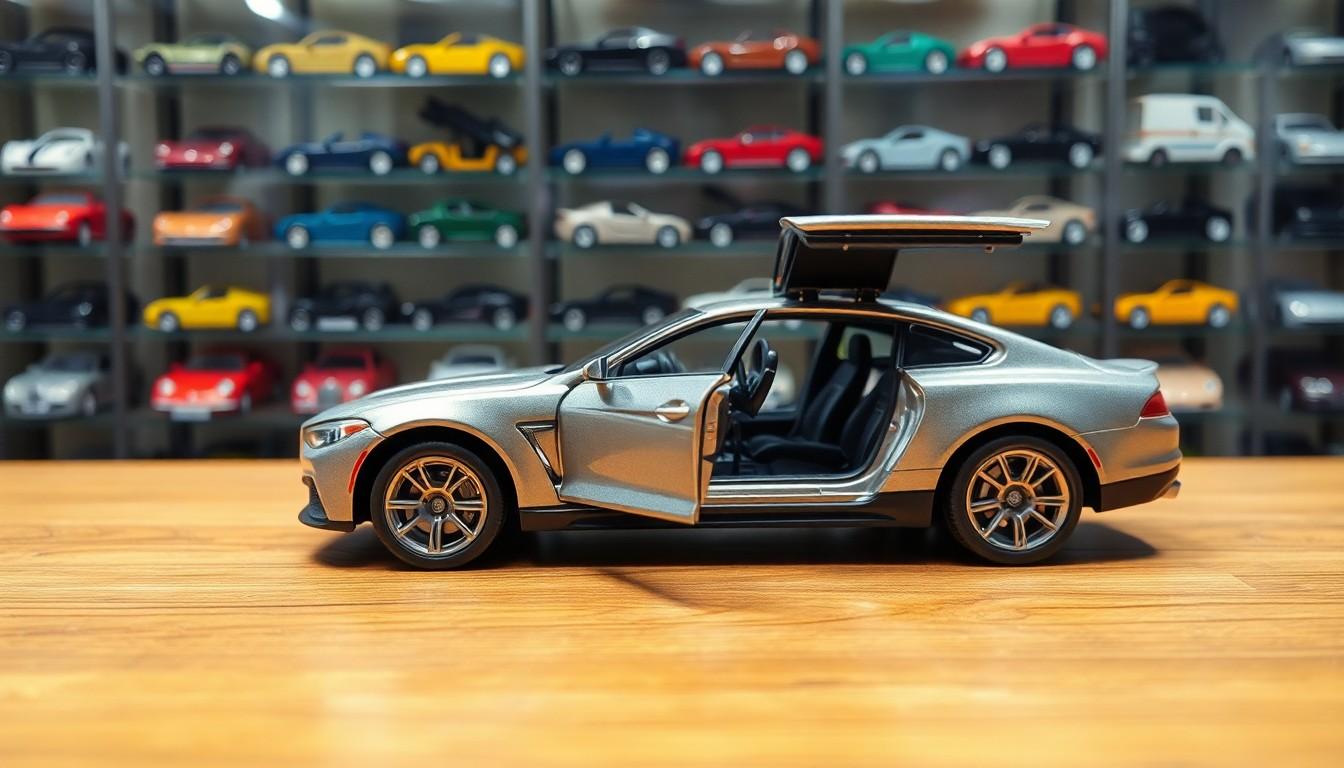Imagine holding a tiny car in your hand. Its metal body is cool to the touch, and every detail perfectly mirrors the real thing.
Diecast cars aren’t just toys—miniature works of art, each telling a story of craftsmanship and imagination.
These little vehicles have fascinated collectors for over a century and sparked joy across generations. But how did they go from simple playthings to prized collectibles?
The journey of diecast cars is as remarkable as the cars themselves. Born in the early 1900s, these miniature marvels started with basic designs crafted from zinc alloys with little detail.
Over time, they transformed into intricate models, showcasing everything from classic vintage beauties to sleek modern race cars.
Each evolution brought new surprises, making them treasures for kids and collectors worldwide. Let’s uncover the story behind these tiny yet mighty machines.
Introduction to Diecast Cars
Explanation of Diecast Manufacturing Process

Diecast manufacturing is where the magic happens. It starts with molten metal—usually zinc alloy—injected into a high-pressure mold.
Think of it as pouring liquid metal into a car-shaped cookie cutter, but way more precise. This process creates durable, detailed models with clean lines that stand out from their plastic counterparts.
Once the metal shell is complete, it’s time for paint and finishes, which take weeks to perfect. Designers get crazy with details, adding decals, logos, and moving parts like doors and wheels.
Some of the best models make you double-take, wondering if they’re real cars that shrunk in a dryer. This combo of skill, machinery, and obsession with detail is why diecast cars are more than just collectibles—they’re tiny masterpieces.
Early Development (1900s-1940s)

Diecast cars didn’t start as the collector’s gems we know today.
In the early 20th century, they were humble toy creations molded from heavy metals. Let’s dig into the origins and their earliest forms that got this hobby rolling.
Origins of Diecast Cars
The diecast car journey kicked off in the 1910s. Companies like Tootsietoy in the US and Meccano Ltd. (famous for Dinky Toys) introduced small, metal toy cars in the UK.
The process was simple: molten metal was shot into molds to create solid car-shaped pieces.
These early models weren’t flashy—they lacked the detailing we see now—but they nailed the fun factor and quickly found a spot in kids’ toy chests worldwide.
Early Models Made from Lead
In the early days, manufacturers made these cars using lead. The metal’s affordability and ease of molding were a win for toy makers.
German and other European brands joined the party, churning out basic, sturdy mini cars. These lead models were small and charming, but let’s be real: They were safety hazards waiting to happen.
Handling them wasn’t exactly risk-free, especially for curious little hands.
By the 1930s and 1940s, the industry had enough of lead’s downsides (like being toxic) and started transitioning to zinc alloys.
This shift made diecast cars safer and opened up possibilities for cleaner designs and sharper details. That simple switch marked a major turning point, transforming these early toys into collectibles worth cherishing.
Key manufacturers in the early 20th century

Let me take you back to the early 1900s when diecast cars first debuted. It was a time of innovation, artistry, and a pinch of trial and error.
The pioneering manufacturers of the time laid the foundation for the collectibles we cherish today.
Meccano Ltd. and Dinky Toys
Meccano Ltd., based in the UK, was one of the diecast world’s trailblazers. In the 1910s, they began producing toy vehicles that caught the attention of kids and collectors alike.
Fast-forward to 1934, they launched Dinky Toys, which became a household name. These were no basic toys; they had working wheels, detailed bodies, and even moving doors.
Dinky Toys set the bar for craftsmanship and detail, making them iconic in the collector community.
Tootsietoy’s Transformation
Over in the US, Tootsietoy made waves by bringing diecast into the spotlight.
They ditched unreliable tinplate models and started using lead and zinc alloys to craft more durable, detailed cars.
By the 1930s, their diecast models evolved from playthings to miniature art pieces, paving the way for the industry to grow.
Setting the Stage
With Meccano and Tootsietoy in charge, early diecast cars became more than toys—they became collectibles that blended art and engineering.
These brands didn’t just sell cars; they sold imagination and joy that resonated with collectors of all ages.
Transition to zinc alloy in the 1930s

The 1930s marked a turning point for diecast cars. Early models used lead, but safety concerns pushed manufacturers toward zinc alloy, a safer and more versatile material.
Impact of World War I on Manufacturing Techniques
World War I drove advances in manufacturing, which later influenced diecast production. The war demanded efficient mass-production systems and stronger materials for military use.
These innovations later trickled into consumer industries like diecast cars.
By the 1930s, manufacturers applied these techniques to create detailed, durable zinc alloy models that maintained precision and resisted breakage.
Pioneering Brands

Diecast cars owe their legacy to two big names that set the standard: Dinky Toys and Tootsietoy. These brands didn’t just make toys; they changed how people saw miniature models forever.
Introduction of Dinky Toys and Tootsietoy
Dinky Toys, launched in 1934 by Meccano Ltd., brought realism to the table—or the playroom floor.
They weren’t content just making generic cars; their models had working wheels, intricate designs, and even moving features like opening doors.
These tiny vehicles became symbols of innovation and quality, turning amateur collectors into lifelong fans.
On the other hand, Tootsietoy also left its mark as one of the earliest diecast pioneers.
Before anyone was using zinc alloys, Tootsietoy mastered diecast lead cars, experimenting with durability while keeping the fun factor sky-high.
Together, these two brands wrote the rulebook for diecast car manufacturing.
Post-War Boom and Standardization (1950s-1960s)

The diecast car scene exploded in the 1950s, driven by better tech, higher demand, and a love for tiny cars that fit in your pocket.
Following World War II, improvements in manufacturing made these mini marvels more affordable, feeding the growing wave of collectors and kids hooked on wheels.
By the 1960s, the push for standardized scales added uniformity to the market.
Rise of Companies Like Matchbox and Corgi
Matchbox and Corgi flipped the diecast car world on its head during this era. Matchbox, born in 1953, nailed the formula for success with its 1:64 scale cars packed into—you guessed it—matchbox-sized boxes.
They nailed affordability without skimping on detail, making them perfect for playground racers and serious collectors. Who didn’t want a car they could fit in their back pocket?
On the other hand, Corgi stormed in with innovations no one saw coming. In 1956, they debuted models with plastic windows, branding themselves as “The Ones with Windows.”
Their first line included rides like the Ford Consul and Triumph TR2—8 cars that treated detail like an Olympic sport. These windows became a must-have feature for diecast models, setting benchmarks that other brands followed.
Standardization of Scales

Let’s talk sizes. Early diecast cars were all over the place—big, small, medium, you name it. Manufacturers didn’t stick to one size, which was a headache for collectors trying to display their beauties.
Then came the game-changer: scales. These brought order to the chaos, creating consistency and making collecting more fun.
Adoption of Common Scales

In the 1960s, manufacturers finally got it together. They introduced popular scales like 1:43, 1:24, and 1:18. If you’re into these cars, you’ve probably seen them.
- 1:43 Scale: This scale became a favorite and earned the nickname “O scale.” Models in this size are compact yet detailed enough to nail the realism collectors crave. Think classic cars by Dinky Toys or vintage Matchbox. They’re small but mighty.
- 1:24 Scale: This scale is a bit bigger and lets the details shine. It’s perfect for those who love showcasing intricacies like chrome bumpers or custom paint jobs on their shelves.
- 1:18 Scale: These cars are statement pieces. Their larger size means more room for jaw-dropping design and working features. They are perfect for anyone who wants their collection to turn heads.
Standardized scales didn’t just make life easier; they allowed collectors to proudly compare, store, and display models. What’s not to love?
Innovations in Design

Introduction Of Features Like Opening Doors And Detailed Interiors
Today’s diecast cars dazzle collectors with features like opening doors, detailed interiors, and functioning parts.
These realistic details weren’t always standard, but they’ve since become the must-have elements for serious collectors.
Companies like Matchbox and Corgi were in charge of introducing these enhancements during the post-WWII era.
For example, a Corgi with full interiors or operable hoods didn’t just look cool—each feature added excitement and realism.
Imagine popping open the doors on a 1:24 scale model to reveal leather-like seats and tiny control panels. That’s the magic these innovations brought to hobbyists and car buffs alike.
From dashboards to pedals, brands now compete to create intricate interiors that mimic their real-life counterparts, triggering nostalgia and admiration in equal measure.
These features haven’t just captivated hobbyists and raised the bar for what makes a collectible genuinely special.
The Hot Wheels Revolution (1968)

In 1968, Mattel shook up the toy car world with Hot Wheels: diecast cars that were fast, flashy, and full of personality.
These weren’t your everyday miniature models; they were bold, imaginative, and built for action. Kids couldn’t get enough, and collectors? Well, they still haven’t let go.
Mattel’s Entry into the Market
Before Hot Wheels hit the scene, diecast cars were pretty straightforward—realistic but not exciting. Matchbox and other brands dominated the market, sticking to simple designs.
Mattel saw potential in bringing more flair to toy cars, especially since muscle cars were ruling the roads and imaginations of the 1960s.
They turned an idle toy factory into the HQ for a new line of diecast cars.

Hot Wheels launched 16 models, nicknamed the “Sweet 16,” which combined bright colors, wild shapes, and the kind of speed Matchbox hadn’t dreamed of.
Unique Features That Differentiated Hot Wheels From Competitors

Hot Wheels weren’t just pretty; they were revolutionary.
Designers gave these cars a vibe that screamed “cool”—think oversized engines, shiny metallic paint, and sleek custom builds you’d never find at a dealership.
The innovation didn’t stop there.
Low-friction wheels paired with thin axles meant these cars flew across tracks like rockets.
Hot Wheels tracks sealed the deal, giving kids the ultimate base to race, jump, and loop their cars. While Matchbox focused on realism, Hot Wheels doubled on fantasy, speed, and fun.
Challenges and Resurgence (1970s-1990s)
The world of diecast cars hit a bumpy road from the 1970s to the 1990s.
Kids swapped tiny metal cars for flashing screens, and manufacturers faced an uphill battle to keep the magic alive. Here’s how the industry veered off course—and the clever ways it got back on track.
Decline in Popularity
In the 1970s and 1980s, diecast cars started losing their shine.
Once must-have treasures for kids and collectors, they now struggled to compete with the rise of electronic toys and video games.
Back then, kids were glued to shiny new consoles like Atari and Nintendo, leaving less room for traditional toys. Diecast models couldn’t blink, beep, or blast alien invaders, and suddenly, they seemed… boring.
Manufacturers saw sales plummet as kids traded vibrant model cars for pixelated adventures. For collectors, it was disheartening. A world dominated by imagination began to feel outdated in the face of batteries and button-mashing.
Shift Towards Electronic Toys and Video Games

You couldn’t deny it—tech had turned toys on their heads by the 1980s.
Electronic toys brought reactivity, lights, and sound, making diecast cars appear static and simplistic.
Video games took things further by offering interactive, cinematic experiences. They could let you drive a virtual car through cities or race through digital tracks, effectively replacing the thrill of pushing a car across the floor.

Even diecast mainstays like Matchbox and Hot Wheels faced this shift.
While kids lined up for flashy new gadgets, diecast cars stalled in toy aisles, bypassed by battery-powered competitors. Popularity plummeted. For companies rooted in this craft, it wasn’t just an adjustment—it was survival.
Yet, like all good comeback stories, diecast manufacturers fought back. They began adapting to stay relevant, but those clever pivots come later in the story. For now, let’s just say they weren’t done driving forward.
Emergence of Adult Collectors
Diecast cars aren’t just toys anymore; they’ve become prized collectibles for grown-ups.
Nostalgia and community have fueled this shift, turning childhood hobbies into serious pursuits with a loyal following.
Nostalgia-Driven Market For Vintage Models

Many of us couldn’t get enough of those shiny little cars as kids. Fast-forward a few decades, and we’re still chasing them—but now, vintage models with character and history steal the spotlight.
Adults are rekindling childhood memories by hunting classic diecast cars they missed out on or cherished in their youth.
Manufacturers picked up on this nostalgia-fueled demand and started producing high-detail replicas of iconic cars from the past.
Think 1960s muscle cars or 1950s cruisers, meticulously recreated in miniature.
This attention to detail attracts collectors and car enthusiasts who display these models like trophies. These aren’t just “toys”; they’re tiny time machines that bring the past roaring back.
Growth Of Collector Communities And Conventions
Collecting diecast cars isn’t a solo act these days—it’s an event! Collector communities have exploded, with forums, social media groups, and even entire conventions dedicated to these miniature marvels.
If you’ve ever attended a diecast car convention, you know the energy is contagious. People bring their best finds to show off, swap stories, and sometimes engage in friendly trading.
These gatherings do more than showcase collections; they create camaraderie. Collectors meet fellow enthusiasts who “get” their obsession, making the whole experience richer.
It’s common to see limited-edition releases debuting at conventions, adding to the thrill. Whether you’re buying, selling, or just gawking, these events are where diecast dreams come alive.
Modern Era and Future Trends (2000s-Present)

The diecast world got a major glow-up in the 2000s. Thanks to tech like CAD and 3D printing, today’s diecast cars look stunningly real.
Designers now nail every little detail—shiny paint jobs, logo-perfect decals, and even tiny seats inside. It’s like someone hit “zoom” on your favorite car and shrunk it down flawlessly.
What’s cool is how much they pack into these mini-models. Opening doors? Check. Realistic interiors with dashboards? Check. Hoods that pop open to reveal a perfectly detailed engine? You bet.
Manufacturers have used partnerships to level up their work.
By licensing designs directly from real automakers, they can mirror every curve and feature. This teamwork ensures authenticity, so collectors know they’re getting faithful replicas of iconic cars—a classic Mustang or a sleek Lamborghini.
Looking forward, trends are shifting. Eco-conscious production with sustainable materials is becoming a focus. Plus, custom 3D-printed diecast models could someday give fans a chance to own one-of-a-kind pieces.
If tech keeps soaring, who knows? Maybe fully interactive diecast cars aren’t too far off.
Conclusion
Diecast cars have come a long way, transforming from simple playthings into intricate collectibles that bridge artistry, nostalgia, and innovation.
Their enduring appeal lies in the perfect blend of craftsmanship and storytelling, capturing the imagination of enthusiasts across generations.
As technology continues to push boundaries, diecast cars remain a testament to creativity and passion.
Whether you’re a seasoned collector or just starting out, these miniature masterpieces offer a timeless connection to the world of automobiles and the joy of discovery.

